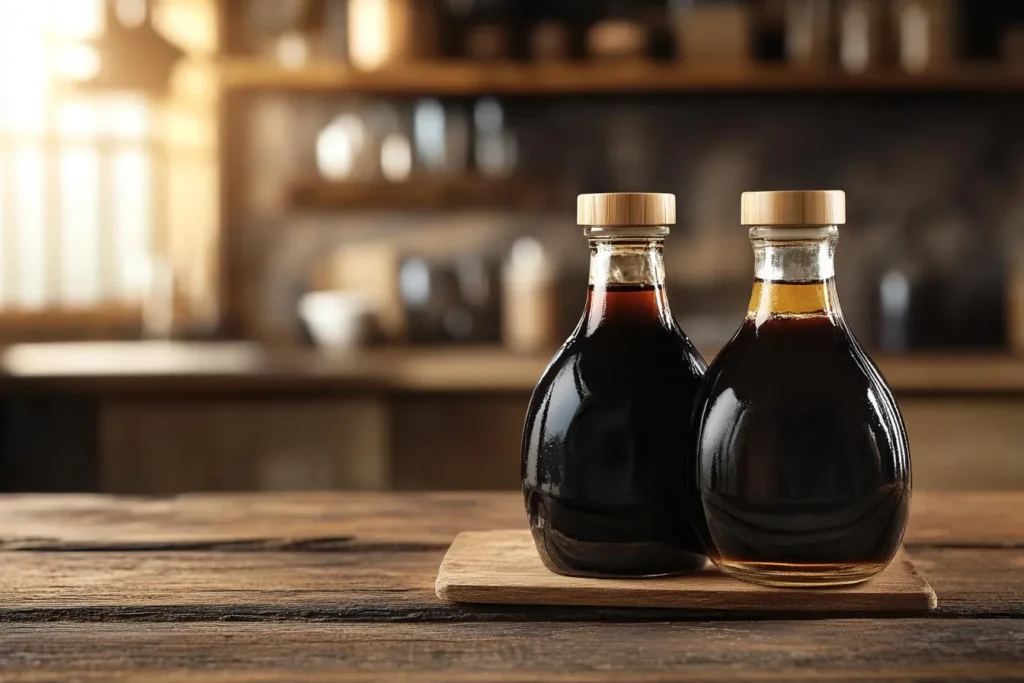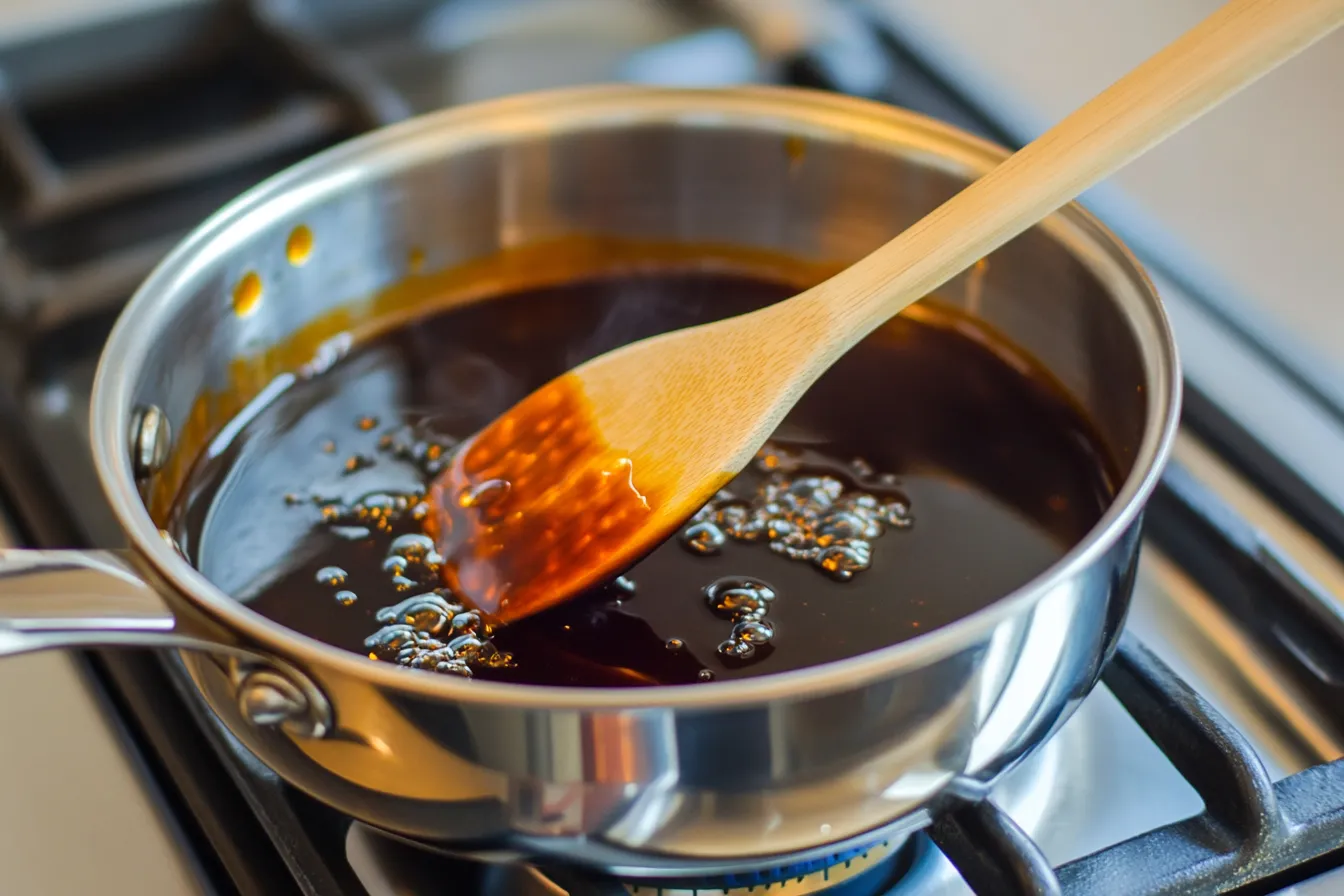Introduction
Crossword lovers know the thrill of solving a tricky clue, especially when it ties into something as delicious as cooking. One clue that’s been trending recently is “glaze made with soy sauce and mirin.” If you’ve come across this clue in your daily crossword and it stumped you, you’re not alone. In fact, food-themed crossword clues are becoming more popular, blending culinary culture with wordplay.
This particular clue refers to a glaze that combines two well-known Japanese ingredients — soy sauce and mirin. These ingredients aren’t just crossword material; they’re kitchen staples that create rich, complex flavors. In this blog, we’ll break down exactly what this crossword clue means, explore the traditional glazes made from soy sauce and mirin, give you a hand with possible crossword answers, and even share practical cooking tips along the way.
Whether you’re a crossword buff, a foodie, or a curious cook, this guide will help you solve the puzzle and expand your culinary knowledge. Let’s dive in!
Understanding the Crossword Clue
What does “glaze made with soy sauce and mirin” mean?
In the world of crosswords, clues often rely on shared cultural knowledge. The phrase “glaze made with soy sauce and mirin” points directly to a sweet-and-savory sauce popular in Japanese cuisine. Mirin is a type of sweet rice wine, while soy sauce is a salty, fermented soy-based liquid. When combined, they make a glossy, umami-rich glaze that coats grilled or broiled foods perfectly.
Traditionally, this glaze is used on dishes like teriyaki chicken or grilled skewered meats (known as yakitori). The high sugar content of mirin helps the glaze caramelize beautifully, while soy sauce provides that deep, savory note that Japanese cooking is famous for..Homemade Caesar Dressing Recipe
Common crossword answers for this clue
So, what’s the actual answer in the crossword? Most commonly, the solution is TERIYAKI, which is a classic glaze combining soy sauce, mirin, sugar, and sometimes sake. Other possible answers you might see include YAKITORI, referring to the grilled chicken skewers that use this sauce, or even KABAYAKI, a style of grilled eel glazed with a similar sauce.
If the crossword is looking for a short, 7-letter word for a Japanese glaze with soy sauce and mirin, TERIYAKI is almost certainly the answer.
Pro tip: When you see “soy sauce + mirin” in any crossword puzzle, think teriyaki first!
Soy Sauce and Mirin: The Delicious Duo
What is soy sauce?
Soy sauce is a staple ingredient in East Asian cooking. It’s made by fermenting soybeans with wheat, salt, and water, producing a salty, complex flavor profile that adds instant umami to almost any dish. In Japan, soy sauce (or shoyu) is central to countless sauces and marinades, including teriyaki glaze.
Soy sauce not only seasons food but also brings depth, color, and that signature savory punch that balances sweetness in glazes.
What is mirin?
Mirin is a type of sweet rice wine with low alcohol content, traditionally used in Japanese cooking to add sweetness and shine to sauces. It has a syrupy texture and a mellow, honey-like flavor that complements the saltiness of soy sauce beautifully. Mirin also helps sauces adhere to food, making it a critical element of glazes.
If you’d like to learn more about mirin and how to use it, check out this helpful guide on Epicurious.
Why are they paired together?
Pairing soy sauce with mirin creates a perfect sweet-savory harmony. The saltiness of soy sauce is balanced by the sweetness of mirin, while the alcohol in mirin gently evaporates during cooking, leaving a glossy, rich glaze. This combination is the backbone of many Japanese sauces, from teriyaki to unagi no tare (eel sauce).
It’s no wonder that crossword writers love referencing this pair — it’s a culinary classic with deep cultural roots.

Popular Glazes with Soy Sauce and Mirin
Teriyaki glaze
Perhaps the most famous glaze made with soy sauce and mirin is teriyaki. Teriyaki sauce blends soy sauce, mirin, sugar, and sometimes sake to form a sticky, shiny, flavor-packed coating that caramelizes beautifully on meat, fish, or even vegetables. The word “teriyaki” comes from “teri,” meaning luster, and “yaki,” meaning grilled or broiled, which describes the technique of broiling or grilling food while repeatedly brushing on this glaze.
Classic teriyaki glaze has a wonderful balance: salty from the soy sauce, sweet from the mirin, and just a bit of depth from sugar. It’s used on chicken, salmon, beef, and even tofu. If you want to recreate a traditional Japanese teriyaki flavor at home, combine equal parts soy sauce and mirin, add a tablespoon of sugar, and gently simmer until it thickens. Brush it on while grilling — you’ll have a restaurant-worthy taste in your own kitchen..Creamy Tuscan Chicken
If you’d like to explore making your own teriyaki, check out this in-depth guide to homemade teriyaki glaze for inspiration.
Yakitori sauce
Another glaze that uses soy sauce and mirin is yakitori sauce, traditionally brushed over skewered chicken grilled on charcoal. This sauce, also called tare, features soy sauce, mirin, sugar, and sometimes sake or dashi stock for extra depth. It creates a sticky, flavorful exterior that chars slightly when grilled, giving yakitori its iconic look and taste.
Yakitori sauce is usually simmered until it thickens to a syrup-like consistency. Chefs will sometimes reuse leftover sauce from one batch to enrich the next batch, a practice called kaeshi that layers flavors over time. Yakitori is one of Japan’s favorite street foods, and the glaze is a big reason for its popularity.
Homemade glaze recipe
Want to try your own glaze at home? Here’s a simple recipe:
- ¼ cup soy sauce
- ¼ cup mirin
- 2 tablespoons sugar
- 1 tablespoon sake (optional)
Mix all ingredients in a small saucepan over low heat. Stir until the sugar dissolves and the sauce begins to thicken (about 5–7 minutes). Remove from heat, cool slightly, and brush over your grilled chicken, salmon, or vegetables.
If you don’t have sake, just use a little water instead. The glaze should be shiny and slightly sticky, giving your food that classic Japanese flavor.
Solving the Crossword Clue
Crossword strategy tips
When you face crossword clues with food references, try thinking broadly about cuisines and dishes. Clues mentioning “glaze,” “soy sauce,” and “mirin” nearly always point toward Japanese food, which narrows your choices. Also, pay attention to the letter count provided in the crossword puzzle, as that’s the best hint to guide you.
If you see 7 letters, TERIYAKI is the most likely answer. If you see 8 letters, YAKITORI could be the winner. Keep in mind the context of the other clues, too, as crosswords often build on each other.
Common 5-letter and 7-letter answers
Here’s a cheat sheet for quick solving:
- 5 letters: TARE (the general term for Japanese grilling sauces)
- 7 letters: TERIYAKI
- 8 letters: YAKITORI or KABAYAKI
If you struggle with unusual clues, use online crossword tools like Crossword Solver to help you fill in tricky gaps.
Using online crossword solvers
Crossword solvers can help you confirm the answer if you feel stuck. Simply enter the clue and the letter count, and the tool will suggest possible answers. It’s not cheating — it’s a learning tool that makes you a stronger puzzle-solver in the long run.
Also, keep practicing! The more crossword puzzles you do, the faster you’ll recognize recurring food-related clues.

FAQs about Soy Sauce and Mirin Glaze
Crosswords aside, people are often curious about soy sauce and mirin when it comes to cooking, dietary restrictions, and substitutions. Here are the most common questions about this classic Japanese glaze.
Can I substitute mirin?
Absolutely — if you don’t have mirin on hand, there are some decent substitutes. The easiest is a mix of dry sherry or a mild white wine with a bit of sugar. A common replacement ratio is 1 tablespoon of dry sherry plus ½ teaspoon of sugar to mimic mirin’s sweetness. Another option is rice vinegar mixed with sugar, though it will be slightly tangier than authentic mirin.
Keep in mind that true mirin adds a unique syrupy body and mild aroma that’s tough to exactly duplicate. For best results, look for hon-mirin (authentic mirin) at an Asian market.
Is this glaze gluten-free?
Great question. Traditional soy sauce is brewed with wheat, so it usually contains gluten. However, you can swap in tamari (a gluten-free version of soy sauce) to make your glaze safe for gluten-sensitive diets. Mirin itself is generally gluten-free, but always double-check labels, especially if you buy flavored or cooking-style mirin, as those sometimes have added wheat-based ingredients.
If you’re strictly gluten-free, combine tamari with authentic mirin and a sprinkle of sugar, and you’ll still achieve that glossy, delicious finish without gluten.
What dishes use this glaze?
The soy sauce and mirin glaze is incredibly versatile. Here are some top dishes that use it:
- Teriyaki chicken: Juicy grilled or pan-fried chicken coated with teriyaki sauce
- Salmon teriyaki: A staple in Japanese restaurants, made with fresh salmon fillets
- Yakitori skewers: Grilled chicken skewers with a sweet-savory tare
- Unagi (grilled eel): Kabayaki-style eel brushed with a soy-mirin glaze
- Tofu teriyaki: Perfect for vegetarians wanting that same rich flavor
This glaze can even work on eggplants, mushrooms, or zucchini, adding a meaty, satisfying taste to plant-based meals.
Can I store leftover glaze?
Yes! A homemade soy sauce and mirin glaze can be stored in the fridge in a sealed jar for up to two weeks. If you simmer it until slightly thickened, it becomes more stable and less likely to spoil. Just reheat it gently before brushing it on your food again.
What if I burn the glaze?
Because the glaze contains sugar, it can burn quickly over high heat. The key is to brush it on toward the end of cooking and watch carefully. If it does burn, wipe off the charred parts, lower the heat, and reapply a fresh layer. That’s the classic method Japanese chefs use to keep the glaze shiny but not scorched.
More Cooking Tips for Glazes
Balancing flavors
When making your own glaze, don’t be afraid to taste and adjust. If it’s too salty, add a bit more mirin or sugar. If it’s too sweet, add a splash more soy sauce. A well-balanced glaze should taste pleasant even on its own.
How to apply glaze for best results
Brush the glaze on in thin layers rather than dumping it all at once. As you cook, keep adding thin coats to build up shine and flavor gradually. This layering technique, common in yakitori shops, gives that restaurant-quality result.
Trying other variations
If you want to experiment beyond the standard soy sauce + mirin combo, try adding:
- A splash of sake for extra depth
- Fresh grated ginger for heat
- Garlic for a savory punch
- Sesame oil for a nutty aroma
These tweaks can elevate your glaze into something truly signature.

Exploring Japanese Culinary Traditions
The cultural roots of soy sauce and mirin
Soy sauce and mirin aren’t just random pantry staples — they represent centuries of Japanese culinary tradition. Soy sauce (shoyu) has roots going back to the 7th century, inspired by Chinese fermented sauces. Over time, Japanese artisans refined the brewing process, creating the balanced, umami-rich soy sauce that is now a global essential.
Mirin, on the other hand, originated as a sweet alcoholic beverage before evolving into a beloved cooking ingredient. By the Edo period (1603–1868), it had become an indispensable part of Japanese kitchens, giving dishes that lovely shine and mild sweetness that modern chefs still rely on.
When these two come together, they embody the Japanese ideal of umami harmony, blending sweet and savory in a way that brings out the best in simple ingredients. That’s why you’ll see “glaze made with soy sauce and mirin” appear so often, both in crossword puzzles and in restaurant kitchens worldwide.
Influence beyond Japan
These sauces aren’t limited to Japanese cuisine anymore. Teriyaki sauce, for example, has become a global star. From New York food trucks serving teriyaki bowls to home chefs glazing salmon fillets, this flavor combination is loved around the world. Many modern sauces in Western cooking, such as Korean barbecue glazes or Hawaiian poke marinades, borrow elements of soy sauce and mirin for that magical balance of sweet, salty, and umami.
By understanding where these flavors come from, you’ll have more appreciation for their depth — whether you’re solving a crossword or planning dinner.
Regional variations
Different parts of Japan put their own spin on soy sauce and mirin glazes. For example:
- Kansai-style teriyaki: usually slightly sweeter with more mirin
- Kanto-style teriyaki: sharper and saltier, more soy sauce forward
- Nagoya’s miso-based glazes: which sometimes add miso paste to the base glaze for richer flavor
This regional variety shows that even a simple crossword clue can reveal fascinating layers of culinary culture.
Health Benefits and Considerations
Nutritional profile
Soy sauce and mirin do more than just taste good. Soy sauce offers small amounts of protein, antioxidants, and even some minerals thanks to its fermentation process. Mirin contains sugars for quick energy, but it also has trace amounts of amino acids and other flavor-enhancing compounds.
However, it’s wise to use these glazes in moderation since they can be high in sodium and sugar. A little goes a long way, and even a thin brush of glaze delivers powerful flavor without overwhelming your meal’s nutritional balance.
Lower-sodium or sugar-free options
If you’re watching your salt intake, you can switch to reduced-sodium soy sauce or tamari. Similarly, you can replace some of the sugar in your glaze with alternatives like honey or maple syrup, though that will change the flavor profile slightly.
Health-conscious cooks have plenty of options to make soy sauce and mirin-based glazes fit into their diet without sacrificing too much taste.
Serving sizes and mindful eating
Japanese cuisine is rooted in mindful eating — savoring flavors in small, intentional portions. A glaze made with soy sauce and mirin is best used sparingly, brushed on in thin layers to build flavor without overwhelming your dish or spiking sodium intake.
Think of glaze as a finishing accent, not a heavy sauce that drowns the main ingredient. That philosophy helps you enjoy richer flavors while keeping your meals balanced and healthy.
Crossword Puzzle Culture and Food Clues
Why food shows up in crosswords
Food-themed clues have become increasingly popular in modern crossword culture. Why? Because food is relatable, familiar, and usually memorable — everyone eats, so everyone has some frame of reference. Whether it’s “Japanese sweet rice wine” or “grilled chicken skewer glaze,” crossword creators love to test solvers with culinary knowledge that feels fresh but accessible.
A clue like “glaze made with soy sauce and mirin” perfectly hits this sweet spot. It combines a bit of exotic flair with common enough familiarity that even casual crossword solvers might recognize “teriyaki.” Food clues also allow crossword constructors to tie in themes around culture, tradition, and language, which makes the puzzle experience richer and more engaging.
How to get better at food-themed crosswords
If you often get stuck on food-related clues, here are some easy tips:
- Keep a food glossary handy: Jot down unusual terms you come across so you remember them later.
- Look for word roots: Clues that hint at sauces or glazes from Japan, for instance, often involve “yaki” (grilled), “tare” (sauce), or “miso.”
- Practice themed crosswords: Many apps offer food-themed puzzles you can use to build vocabulary and sharpen pattern recognition.
- Read food blogs and cookbooks: The more you expose yourself to food terminology, the more you’ll recognize crossword solutions.
These tricks help you build a mental database, making clues like “glaze made with soy sauce and mirin” a breeze to solve.
Other popular Japanese crossword answers
Beyond teriyaki and yakitori, crosswords often sneak in other Japanese culinary terms, such as:
- UMAMI (5 letters): the “fifth taste”
- SUSHI (5 letters): vinegared rice dish
- MISO (4 letters): fermented soybean paste
- RAMEN (5 letters): noodle soup
So if you’re a regular crossword solver, brushing up on Japanese food vocabulary is a solid strategy!
Cooking with Crossword-Inspired Confidence
Turning crossword knowledge into cooking skill
Solving a crossword clue about glazes can spark a kitchen adventure. Instead of just learning the answer, why not try making the glaze? Once you know teriyaki is the answer, grab some soy sauce and mirin and make it for dinner.
Crosswords can be a fun way to explore new recipes, ingredients, and cooking techniques. In fact, many crossword enthusiasts say they’ve discovered foods they later came to love just because a crossword clue sparked their curiosity.
Easy recipes to try
Here are two quick recipes to turn crossword trivia into tasty action:
- Simple Teriyaki Chicken
- 2 chicken thighs
- 3 tbsp soy sauce
- 3 tbsp mirin
- 1 tbsp sugar
- Grill chicken while brushing with the glaze until cooked through.
- Teriyaki Eggplant
- 1 large eggplant, sliced
- 3 tbsp soy sauce
- 2 tbsp mirin
- 1 tbsp honey
- Roast slices brushed with the glaze until golden brown.
Sharing your knowledge
Next time you see “glaze made with soy sauce and mirin” in a crossword, you’ll know the answer and the backstory. Share this knowledge with friends and even teach them to cook with it — that’s a fun conversation starter that goes beyond the puzzle.
Crosswords can be more than word games; they’re also gateways to cultural appreciation and culinary discovery.
Conclusion
The next time you spot the crossword clue “glaze made with soy sauce and mirin,” you’ll know the answer is almost certainly teriyaki — or in some variations, yakitori or kabayaki. Beyond crossword puzzles, though, this clue unlocks a fascinating look at Japanese culinary tradition. From the balanced sweetness of mirin to the deep umami of soy sauce, these ingredients form the backbone of countless Japanese dishes, adding flavor, shine, and cultural meaning.
Food-themed crossword clues are fun because they challenge you while also sparking new knowledge. You might walk away not only with the right word but also with fresh ideas for your next meal. Teriyaki, yakitori, or any soy-mirin glaze is more than a crossword solution — it’s a culinary experience you can recreate at home.
So the next time you’re grilling chicken, broiling fish, or even sautéing eggplant, think about brushing on a simple soy sauce and mirin glaze. With just a few ingredients, you’ll bring restaurant-quality flavor into your own kitchen while celebrating a small piece of Japanese food culture.

Name: Teriyaki Glaze (Soy Sauce and Mirin Glaze)
Ingredients
Equipment
Method
- Instructions:
- Combine the soy sauce, mirin, sugar, and sake (if using) in a small saucepan.
- Place over low heat and stir gently until the sugar dissolves completely.
- Simmer the mixture for 5–7 minutes, stirring occasionally, until it thickens slightly into a glossy glaze.
- Remove from heat and let cool slightly.
- Brush over grilled or broiled foods during the last few minutes of cooking for a sweet-savory finish.
